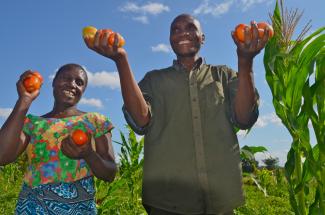While Tanzania’s economy has steadily grown over the past decade, over 49 percent of Tanzania’s population lives on less than $1.90 a day (World Bank, 2011). Malnutrition remains high. Over 34 percent of children under age five are stunted and nearly 45 percent of women of reproductive age are anemic. To help Tanzania achieve the second Sustainable Development Goal—to end hunger, promote sustainable agriculture, and achieve food security and improved nutrition—USAID is working closely with the country to address these challenges.
Tanzania’s agriculture sector—which contributes nearly one-third of the country’s GDP and employs 75 percent of the population—has the potential to increase incomes and improve livelihoods. Feed the Future – the United States Government’s global hunger and food security initiative – supports plans, led by Tanzania, to reduce poverty and improve nutrition.
Tanzania is focusing on agriculture as a means to achieve economic growth. Its plans incorporate private sector engagement including the Southern Agricultural Growth Corridor of Tanzania initiative, a public-private partnership to increase agricultural business investments in the country’s southern corridor.
Feed the Future makes targeted investments emphasizing private sector development to ensure long-term sustainability of poverty reduction and nutrition goals. These investments help smallholder farmers be more competitive in producing and marketing staple foods like rice and maize, increase production of horticulture products (vegetables and fruits), and construct rural feeder roads to improve farmers’ access to markets.
To improve nutrition, Feed the Future promotes the consumption of high-quality nutritious foods and improved food processing techniques such as fortifying flour with micronutrients like iron, vitamin A, zinc, and folic acid.
Furthermore, private sector investment and policy initiatives improve the business enabling environment to promote agricultural growth. Research activities conducted in partnership with local institutions help build the capacity necessary for long-term agricultural development.
Challenges
- Limited access to productive and financial resources, weak infrastructure, and poor policies reduce incentives to develop the agriculture sector.
- Private-sector investment in agriculture is constrained by limited access to long-term capital, low levels of capacity and business skills, and policies which discourage growth.
- Climate change poses significant risks of prolonged drought and unpredictable weather, threatening the livelihoods of subsistence farmers.
- Rapid population growth and agricultural expansion pose a threat to Tanzania’s natural resources that, when managed effectively, support livelihoods and agriculture.
Impact
- Improvements in agriculture: Over 190,000 hectares of land are now under improved technologies/agriculture practices.
- Productivity gains: Productivity of rice per acre for participating farmers has nearly doubled.
- Sector-wide gains: At least 450,000 people have benefited from Feed the Future value chain interventions.
RELATED FACT SHEETS
Overview: Agriculture and Food Security
Activity Fact Sheets
Capacity Building in Agriculture - USDA
Feed the Future Tanzania Activities
- Advancing Youth
- Africa Rising - Phase II
- Agriculture Sector Policy and Institutional Reforms Strengthening (ASPIRES)
- Enabling Growth through Investment and Enterprise (ENGINE)
- Land Tenure Assistance
- Mboga na Matunda (Vegetables and Fruits)
- Nafaka (Grains)
Lishe Endelevu - Sustainable Nutrition
STORIES
The Seed Multiplier: Sowing Seeds of Self Reliance

Paul Weisenfeld/USAID
